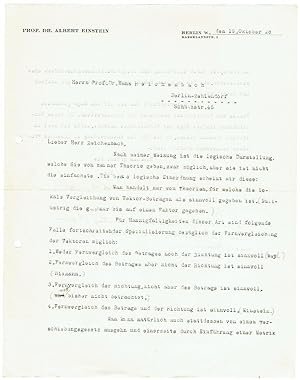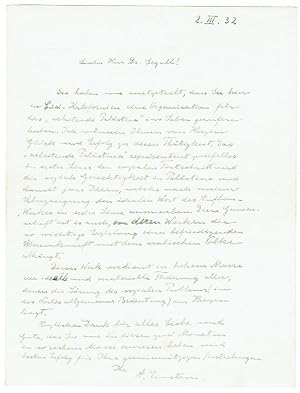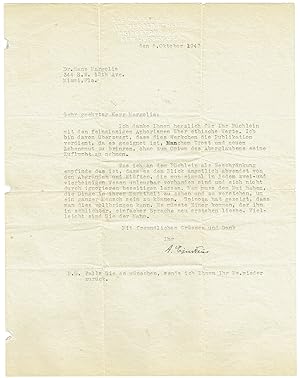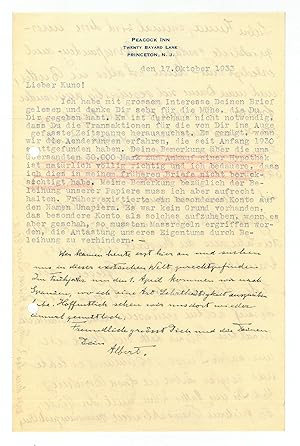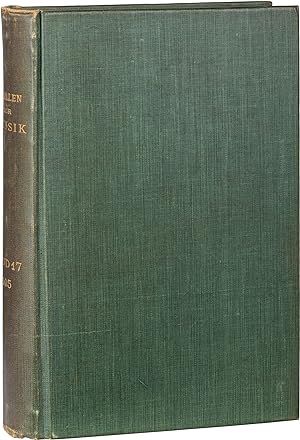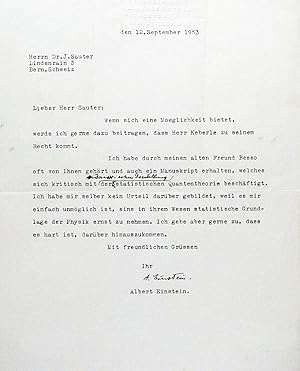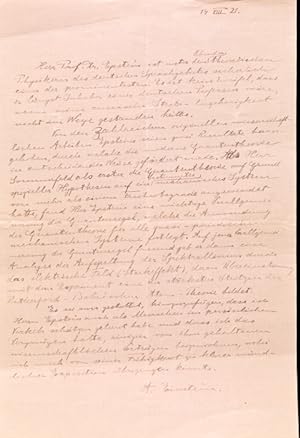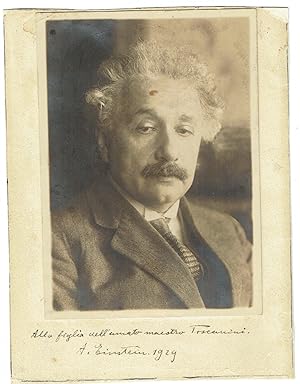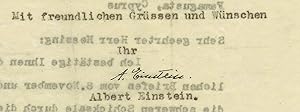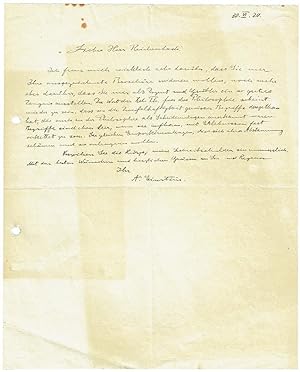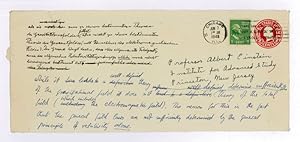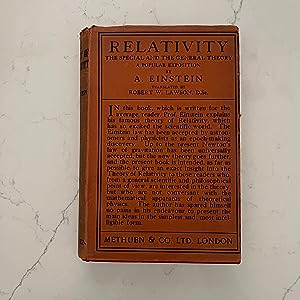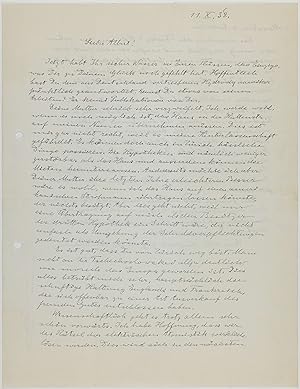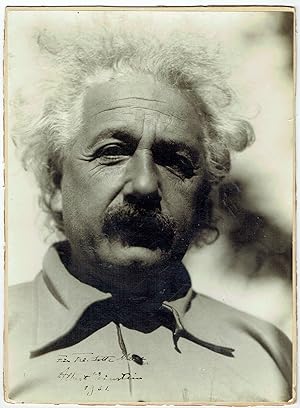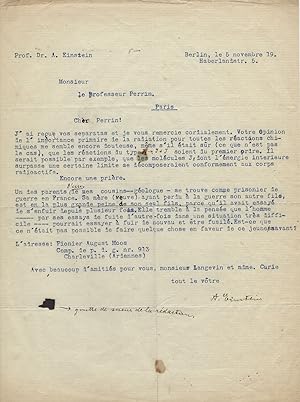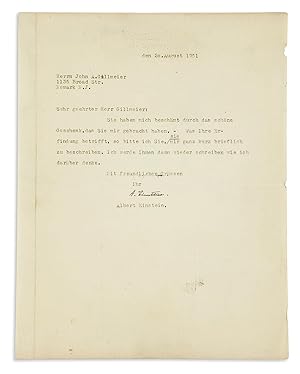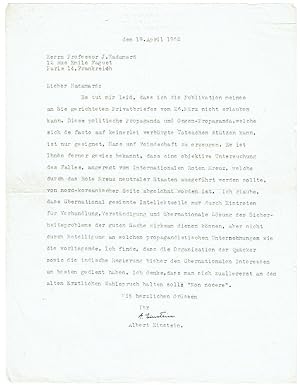albert einstein (Más de 9.800 resultados)
Tipo de artículo
- Todo tipo de artículos
- Libros (9.777)
- Revistas y publicaciones (8)
- Cómics (2)
- Partituras
- Arte, grabados y pósters (2)
- Fotografías
- Mapas
-
Manuscritos y
coleccionismo de papel (58)
Condición
Encuadernación
Más atributos
- Primera edición (851)
- Firmado (69)
- Sobrecubierta (722)
- Con imágenes del vendedor (2.859)
- Sin impresión bajo demanda (9.081)
Gastos de envío gratis
Ubicación del vendedor
Valoración de los vendedores
-
Wesen der Relativitätstheorie". Autograph manuscript.
Publicado por No place, [1947-1948]., 1948
Librería: Kotte Autographs GmbH, Roßhaupten, Alemania
Manuscrito
Small folio. 5½ pp. On paper watermarked "Whiting Mutual Bond Rag Content". German-language draft for "The Essence of the Theory of Relativity", an article published in English within volume XVI of "The American Peoples Encyclopedia" (1948). After a general introduction, the "special theory of relativity" and the "general theory of relativity" are discussed, with a few equations and a small graph sketch. "Die Mathematik hat es ausschliesslich zu thun mit der Beziehung von Begriffen zu einander ohne Rücksicht auf die Beziehung zu Erfahrungs-Gegenständen. Die Physik hat es zwar auch mit mathematischen Begriffen zu thun; diese Begriffe erlangen aber physikalischen Inhalt nur dadurch, dass ihre Beziehung zu Erfahrungs-Gegenständen in klarer Weise festgelegt wird. So verhält es sich im Besonderen auch mit den Begriffen Bewegung, Raum, Zeit. Die Relativitätstheorie ist jene physikalische Theorie, die auf einer konsequenten physikalischen Interpretation dieser drei Begriffe beruht. Der Name Relativitätstheorie hängt damit zusammen, dass Bewegung vom Standpunkt der Erfahrbarkeit stets als relative Bewegung eines Dinges gegen andere (z. B. eines Wagens gegenüber dem Erdboden, oder der Erde gegenüber der Sonne und den Fixsternen) auftritt (Bewegung ist aber nicht wahrnehmbar als Bewegung gegen den Raum oder wie man es auch ausgedrückt hat als absolute Bewegung ). Das Relativitätsprinzip im weitesten Sinne ist in der Aussage enthalten: Die Gesamtheit der physikalischen Phänomene ist so beschaffen, dass sie für die Aufstellung des Begriffes absolute Bewegung keinen Anhalt bietet, oder kürzer aber weniger präzis: Es gibt keine absolute Bewegung [.]". Traces of a paperclip with a slight rustmark to the first leaf.
-
The Building Blocks of Albert Einstein s Creative Mind
Publicado por Germany, 1880
Librería: Seth Kaller Inc., White Plains, NY, Estados Unidos de America
No binding. Condición: Fine. Ephemera. Set of Anker-Steinbaukasten children's building blocks by F. Ad. Richter & Cie., Rudolstadt, [Germany], c.1880s. Approximately 160 composite quartz sand, chalk, and linseed oil blocks in red, limestone and slate gray, in various sizes and shapes, together with three or more sets of building plans, all contained in two wooden boxes with printed Anker-Steinbaukasten labels. A unique and important artifact of his childhood. Einstein spent his childhood building "complicated structures" with these Anker-Steinbaukasten blocks. Accepting his later theory that "Imagination is more important than knowledge," the toys that encouraged his imagination became building blocks for the most important scientific theories of the last millennium.His sister Maja Winteler-Einstein, describing his childhood, recalled that "The games he played . were very characteristic of Albert's capacities. These were mostly puzzles, fretsaw work, the erection of complicated structures with the well-known Anker building blocks, and above all the construction of multi-storied card castles, with which he filled his leisure." ("Beitrag für sein Lebensbild" in The collected papers of Albert Einstein. ed. John Stachel. Volume 1: The early years. 1879-1902. (Princeton University Press, 1987) p.lix. Translated from German.)Based on the work of German educator Friedrich Froebel (who created the concept of kindergarten) these composite stone blocks were a popular toy of the 1880s and 1890s. The blocks were designed to help develop childrens' tactile senses and manual dexterity, and also to stimulate imagination, creativity and three-dimensional perception. Fellow scientist J. Robert Oppenheimer, as well as architects Frank Lloyd Wright and Walter Gropius are among the geniuses who are known to have played with Anker blocks. ProvenanceThe set had passed by direct descent from Albert Einstein to the consignor from whom we acquired the blocks at Christie's London on July 13, 2016. ConditionA few blocks chipped and worn, with original instructions and boxes worn, soiled and defective.Albert Einstein (1879-1955) was a German-Swiss born theoretical physicist internationally recognized as one of the greatest physicists of all time. He enunciated the general theory of Relativity, with law explaining the relationship between the speed of light and its consequence, the equivalence of mass and energy (E=MC2). For his work in theoretical physics-largely for his 1905 paper on photons and photo-electricity-Einstein was awarded the Nobel Prize for Physics (announced in November 1922, retroactive for 1921). Working on a unified field theory, he then attempted to explain gravitation and electromagnetism within one set of laws. With the expulsion of Jewish scholars from Germany after Hitler's rise to power, Einstein joined the Institute for Advanced Study in Princeton, New Jersey (1933), which became the most celebrated research center in the world. In 1939, he signed a letter written to President Franklin Roosevelt warning him of the possibility of Germany developing a nuclear bomb. He urged the U.S. to begin uranium research, thus beginning the top secret "Manhattan Project." Later, at Princeton, he tried to develop a unified field theory and to refute the accepted interpretation of quantum physics, both unsuccessfully. Einstein received U.S. citizenship in 1940. Ephemera.
-
Die formale Grundlage der allgemeinen Relativitätstheorie. Author s presentation offprint from Sitzungsberichte der Königlich Preussischen Akademie der Wissenschaften, XLI, 19 November 1914.
Publicado por Berlin: Königlichen Akademie der Wissenschaften, 1914., 1914
Librería: Kotte Autographs GmbH, Roßhaupten, Alemania
Manuscrito Original o primera edición Ejemplar firmado
Gr.-8vo. S. 1030-85. OBrosch. (Sitzungsberichte der königl. preussischen Akademie der Wissenschaften XLI). Leichte Knickfalten durch Versand. Geringe Gebrauchsspuren. Die erste ausführliche Darstellung der Relativitätstheorie, deren komplizierte Formeln Einstein in der bekannten endgültigen Ausgabe von 1916 vereinfachte. Vorliegende Ausgabe ist wesentlich seltener als die endgültige Fassung. Oberhalb der gedruckten Widmung Überreicht vom Verfasser" befindet sich der eigenhändige Zusatz Einsteins Mit aller Hochachtung", ferner mit eigenhändiger Formelabwandlung (S. 1069) und eigenhändigem Eintrag (S. 1072) in Tinte. Hier ist benutzt, dass auch das System K 2 dem invarianten [oder: unvariiertem] Felde angepasst ist". First edition of this extremely rare offprint inscribed by Einstein Mit aller Hochachtung" ÜBERREICHT VOM VERFASSER. Mit einer Echtheitsbestätigung vom Wiener Antiquariat Ingo Nebehay vom 6.5.1982.
-
Einstein: My Work in Relativity Supplanted Newtonian Mechanics and Changed Our Notion of Space and Time Forever ("In classical mechanics, space and time were completed existences, which had to be presupposed as real [a priori] in order to give meaning to the laws of motion. It was a reality in the same sense as the reality of matter; even governing the latter. In this sense Kant was entirely wrong.")
Librería: The Raab Collection, Ardmore, PA, Estados Unidos de America
The fullest summation we have seen by Einstein comparing relativity to Newtonian concepts of space and timeImmanuel Kant took both Euclidean geometry and the Newtonian laws of motion to be synthetic a priori principles, which, from Kant's point of view, function as necessary presuppositions for applying our fundamental concepts of space, time, matter, and motion to our sensible experience of the natural world, meaning they are fixed necessary conditions. This idea rested on the absolute nature of space and time, the work of Newton, and the relationship between geometry and physics.In 1905, while a young patent clerk and physicist in Bern, Switzerland, Albert Einstein obtained his doctorate and published a paper that explained his newly developed Special Theory of Relativity. This unlocked many mysteries of the universe, and introduced the world to "e=mc2," equating mass and the speed of light with energy. It established that time and space are not fixed, and in fact change to maintain a constant speed of light regardless of the relative motions of sources and observers. Just 10 years later, in 1915, Einstein published his General Theory of Relativity, which described the universe as a four-dimensional continuum (with time added as the fourth dimension), where gravitational effects are explained by the warping of space-time. In this theory, Einstein incorporated gravity as a geometric property of space-time.The impact of Einstein's work between 1905 and 1915 challenged many principles of physics that had been accepted for centuries. In 1921, he won the Nobel Prize for his work. Time Magazine named him the Person of the Century for the 20th century for his discoveries in relativity and space-time. Einstein is the most important scientist since Isaac Newton, and probably the most famous in history.Space and time were considered relativistic, more subjective, and not the fixed a priori notions that had long permeated the mathematical and scientific worlds.Max Fischler was a California scientist who was interested in the implications of this distinction: were space and time now to be studied together in this context only or were the nature of space and the nature of time different?In special relativity, what appears simultaneous to one person, might not to another - they are relative. You cannot separate space and time; they occur subjectively and semi-dependently, but are not tied to the content of that space.With General Relativity, space-time remains but matter warps it. It's a field, like the sheet of a trampoline but reacts to matter. One needs all four dimensions of space-time and without them, the others don't exist. You need matter for space.On September 5, 1954, he wrote to Einstein: ".Can anything in your theory of Relativity be said to throw new light on the nature of space and time themselves? Or must we rest satisfied with the purely new logical treatment of these conceptions? In other words, does the new view of space and time as space-time carry any new meaning ontologically beyond the purely mathematical and logical relationship between the two. Or to put it differently: When Minkowski, in his famous words said, 'Space by itself and time by itself must not sink into the mere shadows, and only a kind of union of the two can preserve an independent existence,' did he not attach some new, real meaning to the 'spacetime' which the old independent notions of space and time could not convey? If so in what does this new meaning consist?."Four days later, Einstein replied in this letter:Typed letter signed, in German, on his personal blind embossed letterhead, Princeton, September 9, 1954, to Max Fishler. "The expression cited in the second paragraph only signifies the wish for logical clarity in the formal expressions. De facto the justification for concepts lies in their ability to comprehend the empirically given."In classical mechanics, space and time were completed existences, which had to be presupposed as real [a priori] in order to give meaning to the laws of motion. It was a reality in the same sense as the reality of matter; even governing the latter. In this sense Kant was entirely wrong."The case was the same as regards the Special Theory of Relativity, only that an objective separation of space and time was abandoned in the sense that there could no longer be any objective simultaneity. Here too the (four dimensional) space is a reality independently of the physical content of space."Regarding the General Theory of Relativity however, this is principally different. What we call "space" is here only an extension of a Field (dimensionality), hence no longer independent of the content of space. It is real in the same sense as matter, but has no real existence independently of matter. When the field is taken away there does not remain any space but just nothing."Letters of Einstein directly relating to relativity are increasingly uncommon, and this is one of the finest such letters we have had.
-
In a Detailed and Unpublished Letter on Classical and Quantum Physics, Albert Einstein Issues a Treatise ? a Scientific Explanation ? Underpinning His Belief That the Universe Cannot Be Random (This remarkable scientific letter shows Einstein's mind at work, and his lifelong quest to not only explain but to validate)
Librería: The Raab Collection, Ardmore, PA, Estados Unidos de America
In this letter from Einstein to David Bohm, Einstein discusses the importance of connecting a key principle of the relatively new theory of quantum mechanics (the "Born interpretation") to physical quantities that can be measured in the real world. To him, it is essential that mathematical theories be connected to measurable quantities. In this letter, Einstein's uneasiness with quantum mechanics is apparent, saying that validation of the seemingly random quantum mechanics "?can only be done on the basis of classical mechanics." Without this validation, quantum theory has essentially "no controllable meaning."Max Born was a renowned physicist who was crucial for the development of quantum mechanics (and also the Ph.D. supervisor of many important physicists including J. Robert Oppenheimer). Quantum mechanics describes the weird behavior of tiny subatomic particles. It's also the guiding theory that led to critical technologies like nuclear power, MRI machines, and transistors in computers and phones. One of Born's biggest contributions to quantum mechanics was the interpretation of the probability density, which is a mathematical operation performed on the "psi-function" (in Einstein's words) to predict the most probable physical quantities of a quantum particle. Einstein believed that probabilities only make sense if you can determine the values that they predict independently by measurement. This is easy to do in classical, Newtonian, mechanics (the physics of big things in everyday life). But Einstein said we can't measure it for something like a "bound electron" (i.e., an electron in an atom). In order to interpret Born's probability density function, you need to connect the mathematics to real values. Einstein's correspondence with Born on this subject is published and famous.To Einstein, the universe is observable and measurable.When confronted with one of the principle tenets of Quantum Mechanics, Einstein remarked, now famously, "Quantum mechanics is very imposing. But an inner voice tells me that it is not the real McCoy. The theory delivers a lot but hardly brings us closer to the secret of the Old One [God]. I for one am convinced that He does not throw dice." This statement was made in one of those significant letters to Born. What he meant here is that rules of science cannot be random, and in the rolling of dice we would have to accept unknown variables and therefore be unable to predict precisely via objective measurements. Therefore, in Quantum Mechanics (as in gambling), an uncertainty of measurement exists. And to Einstein, the universe is observable and measurable. He did not object to Quantum Mechanics per se; indeed he made notable contributions. But he eschewed any reliance on what was not observable and knowable.David Joseph Bohm was an American scientist who has been described as one of the most significant theoretical physicists of the 20th century and who contributed unorthodox ideas to quantum theory, neuropsychology and the philosophy of mind. His first book, Quantum Theory, published in 1951, was well received by Einstein, among others. But Bohm became dissatisfied with the orthodox interpretation of quantum theory he had written about in that book.Bohm's aim was not to set out a deterministic, mechanical viewpoint, but to show that it was possible to attribute properties to an underlying reality, in contrast to the conventional approach. He began to develop his own interpretation (the De Broglie?Bohm theory, also called the Pilot wave theory), the predictions of which agreed perfectly with the non-deterministic quantum theory. He initially referred to his approach as a hidden variable theory. Bohm originally hoped that hidden variables could provide a local, causal, objective description that would resolve or eliminate many of the paradoxes of Quantum Mechanics, the measurement problem and the collapse of the wavefunction. However, Bell's theorem complicates this hope, as it demonstrates that there can be no local hidden variable theory that is compatible with the predictions of Quantum Mechanics. The Bohmian interpretation is causal but not local. Albert Einstein, who had suggested that Bohm search for a realist alternative to the prevailing Copenhagen approach, did not consider Bohm's interpretation to be a satisfactory answer to the quantum question.The Copenhagen interpretation is an expression of the meaning of Quantum Mechanics that was largely devised in the years 1925 to 1927 by Niels Bohr and Werner Heisenberg. It remains one of the most commonly taught interpretations of Quantum Mechanics. According to the Copenhagen interpretation, physical systems generally do not have definite properties prior to being measured, and Quantum Mechanics can only predict the probabilities that measurements will produce certain results. The act of measurement affects the system, causing the set of probabilities to reduce to only one of the possible values immediately after the measurement.In classical mechanics, a particle has, at every moment, an exact position and an exact momentum. These values change deterministically as the particle moves according to Newton's laws. Under the Copenhagen interpretation of Quantum Mechanics, particles do not have exactly determined properties, and when they are measured, the result is randomly drawn from a probability distribution. The Schrödinger equation predicts what the probability distributions are, but fundamentally cannot predict the exact result of each measurement.Typed letter signed, on his blind embossed letterhead, February 17, 1953, Professor Bohm. "Dear Bohm: I thank you very much for the prompt reaction to my little article. I did, of course, not expect that you would agree with me. For scarcely anyone is inclined to abandon an enterprise in which le has invested a great deal of work."I do not want to answer your letter in detail although it deserves it very much. Only a short remark concerning the interpretation of.
-
Albert Einstein Signed Photograph.
Año de publicación: 1923
Librería: Raptis Rare Books, Palm Beach, FL, Estados Unidos de America
Ejemplar firmado
Extremely rare original photograph boldly signed "Albert Einstein Jersusalem 1923" during his only trip to Palestine in 1923. Einstein's return voyage from his tour of Japan and China took him via the Red Sea and Suez Canal which allowed him to accept the invitation of Arthur Ruppin, the director of the Palestine office of the Zionist Organization in Jaffa to visit the region for twelve days. Einstein arrived in Port Said on February 1, 1923, and from there he traveled to Jerusalem, Tel Aviv, Jaffa and Haifa. The photographer, Zvi Oron, began his career in Warsaw and the United States before opening a studio in Tel Aviv in 1919. In 1930 he moved to Jerusalem and opened a studio of Jaffa Street working in the service of press clients and the British Government. He was well regarded for his candid images that captured daily life in the British Mandate. The Zionist archive holds over 1,300 of his negatives. Double matted and framed, the entire piece measures 19.75 inches by 15.5 inches. An exceptional piece. This is the only signed photograph known from his time in Palestine. Albert Einstein developed the general theory of relativity, one of the two pillars of modern physics (alongside quantum mechanics). Einstein's work is also known for its influence on the philosophy of science. Einstein is best known in popular culture for his massâ "energy equivalence formula E = mc2 (which has been dubbed "the world's most famous equation"). He received the 1921 Nobel Prize in Physics for his "services to theoretical physics", in particular his discovery of the law of the photoelectric effect, a pivotal step in the evolution of quantum theory (David Bodanis).
-
EINSTEIN TACKLES ONE OF THE GREATEST UNSOLVED MYSTERIES OF 'MAN'-KIND! -- THE EQUATION OF 'WOMEN' ~~ AS EXPLAINED BY ALBERT EINSTEIN TO HIS SON: ''YOU SEEM TO KEEP KNOCKING ABOUT WITH THE ETERNAL-FEMININE''. ''DON'T STICK WITH THE OLDER GIRLFRIEND RATHER LOOK FOR A HARMLESS GIRLFRIEND, BECAUSE SHE IS MORE LIKE A FRIENDLY GAME, OTHERWISE YOU MAY WELL GET INTO TROUBLE''.
Librería: Gerard A.J. Stodolski, Inc. Autographs, Bedford, NH, Estados Unidos de America
Manuscrito
No Binding. Condición: Fine. EINSTEIN, ALBERT. (1879-1955) German physicist. Revealing Autograph Letter Signed, Papa , in German. One full page, oblong quarto. No place, no date. Very fine condition. To his son, Tetel. Einstein writes: ''Dear Tetel, I was very happy about your letter and about your aphorisms. You seem to keep knocking about with the Eternal-Feminine. But don t stick with the older girlfriend, who is also too sophisticated for you. Rather look for a harmless girlfriend, because she is more like a friendly game, otherwise you may well get into trouble. Toni worries about you a little bit as well, because she is taking the hereditary taint of the Einstein's into account. I liked the aphorisms in all, some of them are very good. Lots of love from Your Dad''. While we ve approached titling the description of this letter somewhat tongue-in-cheek, we take a far more serious position when we say that this letter gives a most remarkable insight into Einstein s approach to women, and his underling psychological attitude towards them. Einstein was married twice, and had at least 10 girlfriends / affairs. His first marriage to Mileva Maric, ended after 16 years together and 2 sons, when he was found cheating with his cousin, Elsa, whom he then married. He then proceeded almost immediately to have another affair with his secretary, Betty Newman. Einstein s somewhat cavalier attitude is shown here, and yet he exhibits and offers obvious caring paternal advice to his son in dealing with the complex calculations of interpersonal relationships. His allusion to the ''hereditary taint of the Einstein's'' just further acknowledges his awareness of his own faults. A remarkable letter that would certainly be a highlight in any collection, while also being the center of conversation whenever seen or exhibited!.
-
Originalphotographie mit eigenh. U. und Widmung für den Photographen ( To Mr Tycko/ Albert Einstein. 1932").
Publicado por O. O., 1932, 1932
Librería: Kotte Autographs GmbH, Roßhaupten, Alemania
Manuscrito
Photographie: 238 : 188mm. Gesamtgröße: 380 : 300mm. Platinum-Abzug. Schönes Brustbild des Nobelpreisträgers, mit Unterschrift in schwarzer Tinte durch den Photographen ( Tycko LA") und mit Prägung des Ateliers des Photographen 'Study by Tycko/ The Ambassador , Berühmte Photographie von Albert Einstein, mit einer Widmung Einsteins für den Photographen. Albert Einstein mochte die Portraits von Aaron Tycko (1833-1975) und verschenkte sie bei Gelegenheit mit Unterschrift versehen and Freunde und Bewunderer. Über den Photographen Aaron Tycko ist wenig, obwohl er ein gefragter Photokünstler war. Neben Einstein lichtete er berühmte Persönlichkeiten wie Jean Paul Getty oder die Schauspielerin Mabel Normand ab. Einstein mochte die Art, wie Tycko fotografierte. Das erzählte Tycko einem der zwischenzeitlichen Besitzer des Bildes. So habe ihm Einstein am 2. März 1932 gesagt, dass er in den Photographien einen wahrhaft künstlerischen Umgang mit Lichteffekten erkennt, durch den die Photographie der Malerei nahekommt". Die Fotoaufnahmen weckten im Nachhinein die Aufmerksamkeit des FBI. Tycko hatte sein Atelier im Ambassador Hotel in Los Angeles. 1955 berichtete Tyckos ehemalige Frau den FBI-Ermittlungsbehörden von Einsteins Besuch. [ ] She said that before their separation she worked with him (Anm: Tycko) in his portrait studio at the Ambassador Hotel in Los Angeles. She recalled that during one of the subject s (Anm.: Einstein) visits to Los Angeles in the early 1930 s, he sat for her husband, and that this photograph was taken in the Athenaeum at the California Institute of Technology, Pasadena, California, where the subject was staying. She said that the subject never sat for her husband in the studio at the Ambassador Hotel, and that she does not recall and does not believe that the subject stayed at the hotel. [ ] It should be noted that, as previously reported, AARON TYCKO has stated that the subject sat for his photograph in his (TYCKO s) studio at the Ambassador Hotel [ ]" (Federal Bureau of Investigation, Subject: Albert Einstein, File Number: 61-7099; 1955) Albert Einstein war bereits ein weltberühmter Physiker, als das FBI im Dezember 1932 eine Geheimakte über ihn anlegte. Er und seine Frau Elsa waren gerade aus Deutschland in die USA ausgewandert und Einstein äußerte sich lautstark zu den sozialen Belangen seiner Zeit. Unter anderem sprach er sich öffentlich gegen Rassismus und Nationalismus aus. Zum Zeitpunkt seines Todes am 18. April 1955 würde die Akte des FBI 1427 Seiten umfassen. Der Leiter der Behörde, J. Edgar Hoover, hegte ein tiefes Misstrauen gegenüber Einsteins Aktivismus. Laut Hoover war es gut möglich, dass der Mann Kommunist sei, aber mit Sicherheit war er ein extremer Radikaler". Das Hotel Ambassador war wichtiger Treffpunkt der Avantgarde im Los Angeles der frühen 1920er bis in die späten 1960er-Jahre. Das Hotel nutzten Hollywood-Schauspieler als Winterresidenz und sein Cocoanut Grove war ein berühmtes Nachtlokal. Der Ballsaal und der Nachtklub waren Schauplatz der ersten großen Oscar-Preisverleihungen und vieler Filmszenen. Traurige Berühmtheit erhielt das Hotel, als dort der demokratische Präsidentschaftskandidat Robert F. Kennedy angeschossen und tödlich verletzt wurde.
-
Autograph Manuscript Signed
Publicado por np, np, 1930
Librería: Manhattan Rare Book Company, ABAA, ILAB, New York, NY, Estados Unidos de America
Manuscrito Original o primera edición Ejemplar firmado
Condición: Fine. First edition. EINSTEIN ON THE CONCEPT OF PEACE: A POWERFUL AUTOGRAPH STATEMENT IN EXCEPTIONALLY LARGE FORMAT. â . Translated from the original German: "No person has the moral right to call himself a Christian or Jew so long as he is prepared to engage in systematic murder at the command of an authority, or allow himself to be used in any way in the service of war or the preparation for it." Starting in 1925, the French Academy began sending large (11.5x16.5) sheets to important scientists, writers, and intellectuals asking them to write on the sheet a statement on the concept of peace for possible inclusion in an anthology. (The World League for Peace later released a limited edition of prints from the submissions under the title Pax Mundi: livre d'or de la paix.) This is Einstein's unique manuscript submission. A highly unusual format with exceptionally large Einstein signature (2.25 in / 6 cm) of an important Einstein statement, consistent with his life-long dedication to pacifism. c.1925-1930. One large folio page (11.5 x 16.5 inches). In German. Fine condition.
-
Annalen der Physik
Año de publicación: 1906
Librería: Bauman Rare Books, Philadelphia, PA, Estados Unidos de America
Original o primera edición Ejemplar firmado
First Edition. "(EINSTEIN, Albert). Annalen der Physik. Vierte Folge. Band 19. No. 2. Leipzig: [Johann Ambrosius Barth], 1906. Octavo, later drab paper wrappers, printed paper spine label; housed in a custom clamshell box. $52,000.First printing of two early and important Einstein papers: a revised edition of his doctoral dissertation, and his paper on Brownian motion, signed by Einstein in 1950 ("A. Einstein (50)") on page 289, the first page of his dissertation.Einstein's doctoral dissertation, "Eine Neue Bestimmung der Molekueldimensionen" [A New Determination of Molecular Dimensions] appears on pp. 289-306, while his follow-up treatise, "Zur Theorie der Brownschen Bewegung" [On the Theory of Brownian Motion] appears on pp. 371-81. Einstein's biographer, physicist Abraham Pais, observed that "it is not sufficiently realized that Einstein's doctoral thesis is one of his most fundamental papers," and historian of science John Stachel, in his monograph "Einstein's Miraculous Year: Five Papers that Changed the Face of Physics" (Princeton: Princeton University Press, 1998), argued that Einstein's doctoral thesis was a landmark work. According to Stachel, Einstein's doctoral thesis "combined the techniques of classical hydrodynamics with those of the theory of diffusion to create a new method for the determination of molecular sizes and of Avogadro's number, a method he applied to solute sugar molecules Einstein's concerns extended beyond this particular question to more general problems of the foundations of the theory of radiation and the existence of atoms. [Einstein] later emphasized 'A precise determination of the size of molecules seems to me of the highest importance because Planck's radiation formula can be tested more precisely through such a determination thorugh measurements on radiation.' The dissertation also marked the first major success in Einstein's effort to find further evidence for the atomic hypothesis, an effort that culminated in his explanation of Brownian motion. By the end of 1905 he had published three independent methods for determining molecular dimensions."Biographies of Einstein such as those produced by Pais and Stachel invariably refer to 1905 as Einstein's "miraculous year" because his articles on relativity, the light-quantum, and Brownian motion appeared almost back-to-back within this extremely productive period. Pais asserted that "in some not all respects, his results on Brownian motion are by-products of his thesis work. This goes a long way toward explaining why the paper on Brownian motion was received by the Annalen der Physik on May 11, 1905, only 11 days after the thesis had been completed. Three weeks after the thesis was accepted, this same journal received a copy [of the thesis] for publication. It was published only after Einstein supplied a brief addendum in January 1906 As a result of these various delays, the thesis appeared as a paper in the Annalen der Physik only after the Brownian article had come out in the same journal. This may have helped create the impression in some quarters that the relation between diffusion and viscosity a very important equation due to Einstein and Sutherland was first obtained in Einstein's paper on Brownian motion. Actually, it first appeared in his thesis" (Pais, Subtle is the Lord: The Science and the Life of Albert Einstein, Oxford, 1982). Einstein's dissertation was first published in Bern, by Wyss, in 1905, in a very small edition, largely for Einstein's own use to secure his doctorate and to apply for jobs. "The judges at the university in Zurich were satisfied with Einstein's results, but Paul Drude, the editor of Annalen, was not. Einstein had submitted his treatise to Drude in August 1905, after the conclusion of the degree procedure; however, it was published not within the customary eight weeks, but only about six months later. This had never before happened with any of Einstein's papers, nor did it ever happen afterward. Drude evidently knew of better data for sugar solutions and must have asked for a small addendum. Einstein supplied it at the beginning of the following year, with a substantially improved result for the Avogadro constant" (Fölsing, Albert Einstein, 127). With folding plate at rear depicting several tables. Weil 7a, 11. This volume was signed by Einstein for Lewis Strauss, Chairman of the Atomic Energy Commission.Interior clean; closed tears to wrappers along spine, binding sound. A very good copy, very rare and desirable signed by Einstein.". Signed.
-
Einstein at Work [Suite of Seven Photographs]
Publicado por np, New York, 1980
Librería: Manhattan Rare Book Company, ABAA, ILAB, New York, NY, Estados Unidos de America
Original o primera edición Ejemplar firmado
Clamshell box. Condición: Fine. First edition. EXTREMELY RARE COMPLETE SUITE OF SEVEN LARGE SILVER PRINTS FROM EINSTEIN'S FAMOUS PHOTO SHOOT AT PRINCETON WITH ROMAN VISHNIAC. Each print is signed by Vishniac and dated "At Princeton 1942" in his hand below the image and numbered on the back. "One day [Vishniac] decided to visit Albert Einstein at Princeton to offer greetings from mutual friends in Berlin. Uninvited, he hoped Einstein would pose for a portrait, but Einstein had little interest. Vishniac recalled: It was a singular experience. An idea had suddenly come to him, and the room was filled with the movement of the great man's thought. I waited several minutes, and then when I saw that he did not intend to say anything more to me and that he was off in a world of his own, I started taking pictures. Einstein later admitted that a Vishniac photograph taken that day was his favorite portrait" (Encyclopedia of Twentieth-Century Photography). Vishniac provided details about this portolfio in a letter to an original recipient (the letter is not included here), explaining: The size of the edition's limitation is uncertain due to my age and only spare time to make them. The most expensive portfolios - Ansel Adams, Kertesz - are limited in large numbers I can never measure up - 999, 1001 and similar. The originality of Portfolio "Einstein" consists of its special character. It is made not to get images, but the feeling that you are present during the creativity by the Great Man. All pictures are made with "hidden camera" method. The value of this portfolio is great and can hardly be estimated today. Princeton/New York: 1942 (negatives); 1980 (silver prints). Elephant folio clamshell box (approx. 17x21 in.) housing seven silver prints. Image size: approx. 10.25 x 13.25 in.; with matte, 16x20 in.) A few minor blemishes to box. Photos in fine condition. RARE.
-
Typed Letter Signed ("A. Einstein") with Autograph Postscript, in German
Publicado por Berlin, October 19, 1928, 1928
Librería: Kotte Autographs GmbH, Roßhaupten, Alemania
Manuscrito
4to. 2 pp. Punch holes. On his personal letterhead. Einstein writes to Reichenbach (1891-1953), a colleague and important expositor of Relativity, to suggest to him a clearer way of explaining one aspect of his theory. He opens the letter by saying (in translation): "I think the logical presentation that you give of my theory is indeed possible, but it's not the simplest one." After providing a list of four possibilities for "increasing specialization regarding the distant comparison of vectors" he comments: "Of course one can also start with an affine connection and specialize either by introducing a metric or by introducing integrability conditions; i.e. do it the way you did. But this is less simple, less natural." He goes on to assert that "[t]he naturalness of the field of structure envisaged by me seems indisputable to me. I will only know in a few months whether this construction contains deeper traits of reality; for the problems needed to be solved to make this decision are not at all easy." The letter ends with a postscript in Einstein's hand, inviting Reichenbach and his wife to tea, noting "Schrödinger is supposed to come as well.".
-
Eigenh. Brief mit Unterschrift.
Publicado por ohne Ort, 2. III. 1932., 1932
Librería: Kotte Autographs GmbH, Roßhaupten, Alemania
Manuscrito
4to. 1 p. An den Wissenschaftler Dr. Gabriel Segall: [ ]Sie haben mir mitgeteilt, dass Sie hier in Süd-Kalifornien eine Organisation für das ,arbeitende Palästina ins Leben gerufen haben. Ich wünsche Ihnen von Herzen Glück und Erfolg zu dieser Thätigkeit. Das ,arbeitende Palästina repräsentiert zweifellos in erster Linie den den sozialen Fortschritt und die soziale Gerechtigkeit in Palästina und damit jene Ideen, welche nach meiner Überzeugung den idealen Wert des Aufbau-Werkes in erster Linie ausmachen. Diese Gemeinschaft ist es auch, von deren Wirken die so wichtige Erzielung einer befriedigenden Übereinkunft mit dem arabischen Volke abhängt [ ]".
-
Beautiful signed photograph.
Publicado por no place, 1933, 1933
Librería: Kotte Autographs GmbH, Roßhaupten, Alemania
Manuscrito Ejemplar firmado
11" x 15" (sight). Black and white headshot of Albert Einstein taken by photographer Aaron Tycko while Einstein was touring the United States between 1932-1933. Signed by Einstein at the bottom left margin, "Albert Einstein. 1933." Signed by Tycko at the bottom right margin, "Tycko / L.A." Matted and framed to an overall size of 18" x 22". Not examined outside of the frame.Frame is lightly scratched and rubbed in places.
-
2 maschinenschr. Briefe mit eigenh. Unterschrift.
Publicado por Princeton, 1943 u. 1950, 1950
Librería: Kotte Autographs GmbH, Roßhaupten, Alemania
Manuscrito
4to. 2 pp. Bliindgeprägter Briefkopf. Faltspuren; an den Rändern mit kleinen Perforierungen. An den Schriftsteller Hans Margolius (1902-1984) in Florida über Ansichten von Kant, Schiller und Spinoza über Ethik und Aberglauben: Ich danke Ihnen herzlich für Ihr Büchlein mit den feinsinnigen Aphorismen über ethische Werte. Ich bin davon überzeugt, dass dies Werkchen die Publikation verdient, da es geeignet ist, Manchem Trost und neuen Lebensmut zu bringen, ohne zum Opium des Aberglaubens seine Zuflucht zu nehmen. Was ich an dem Büchlein als Beschränkung empfinde das ist, dass es den Blick ängstlich abwendet von den Abgründen und Klüften, die nun einmal in jedem zwei- und vierbeinigen Wesen unleugbar vorhanden sind und sich nicht durch ignorieren beseitigen lassen. Man muss den Mut haben, die Dinge in ihrer Nackheit zu sehen und zu verstehen, um ein ganzer Mensch sein zu können. Spinoza hat gezeigt, dass man dies vollbringen kann. Es müsste Einer kommen, der ihn in schlichter, einfache Sprache neu erstehen liesse. Vielleicht sin Sie der Mann. [ ]"Im Brief von 1950: [ ] Sie haben die Unterscheidung zwischen der ethischen Tat bezw. Zielsetzung einerseits und dem Gefühlsmotiv, das zur Tat bezw. Wertung führt andererseits, hübsch ausgeführt. Der Gedanke selbst ist natürlich nicht neu. So ist z.B. Kand drolligerweise so weit in der objectiven Auffassung des Ethischen gegangen, dass er eine Tat nicht als ethisch wertvoll anerkennt, wenn sie unmittelbar einem elementaren Gefühl (z.B. Mitleid) entspringt; er lässt als legitime gefühlsmässige Basis des Ethischen nur das Pflichtbewusstsein gelten, worüber sich schon Schiller lustig gemacht hat. Nach meiner Meinung ist die objective Auffassung, die dem Gegenstand der Ethik angemessens. Die ethische Tat veranlassende emotionelle Situation gehört eigentlich nicht zur Ethik sondern zu Psychologie. [ ]".
-
Typescript letter with six autograph lines signed ("Albert").
Publicado por Peacock Inn, Princeton, NJ, 17. X. 1933., 1933
Librería: Antiquariat INLIBRIS Gilhofer Nfg. GmbH, Vienna, A, Austria
Manuscrito Ejemplar firmado
8vo. 1 p. With an autograph letter signed by Elsa on the reverse. - Includes: 3 autograph letters signed by his wife Elsa Einstein (folio and 8vo; Caputh, 21 August 1932 and no date), one with a 6-line autograph postscript signed by Albert Einstein, and a slip of paper (ca. 40 x 80 mm) with autograph note, date (Princeton, 9 May 1934), and signature in full. Intimate correspondence with Einstein's cousin Kuno Kocherthaler, director of a mining company in Spain and also an art collector. - Typing on hotel stationery on the day of his arrival in the USA as a stateless refugee, having escaped from ever-increasing persecution in Nazi Germany, Einstein thanks Kuno for a letter of his about financial matters, adding below in his own hand: "Wir kamen heute erst hier an und suchen uns in dieser exotischen Welt zurechtzufinden. Im Frühjahr um den 1. April kommen wir nach Spanien, wo ich eine Art Lehrtätigkeit auszuüben habe. Hoffentlich sehen wir uns dort wieder einmal gemütlich [.]". - In an earlier letter of Elsa's, also regarding family investments administered by Kuno (undated but written aboard the "Oakland", probably in the port of Bremen on 10 December 1932, about to depart for a winter cruise to Pasadena via Middle America), Einstein adds a poignant note about his younger son Eduard, who suffered from schizophrenia and had recently been committed to a mental asylum in Switzerland: "Nimm bitte diese schleichende Sorge von uns; das Leben hat in letzter Zeit Schweres gebracht, da mein liebster Sohn, der Jüngere, in einer Anstalt hat untergebracht werden müssen (Geisteskrankheit) [.]". - In the final missive, possibly another postscript torn from a longer letter, Einstein gives his consent in a single word ("Einverstanden"), signing and dating: "Princeton, 9. Mai 1934 / Albert Einstein". Elsa's own letters discuss travel, finances, Albert Einstein's stay in Spa, etc. - Each sheet with marginal binder holes affecting a few letters, otherwise flawless.
-
Three Landmark Papers including Uber einen die Erzeugung und Verwandlung des Lichtes betreffenden heuristischen Gesichtspunkt; In Annalen der Physik, Band 17
Publicado por Barth, Leipzig, 1905
Librería: Biblioctopus, Los Angeles, CA, Estados Unidos de America
Original o primera edición
Hardcover. Condición: Very good. First Edition. 1st edition (in German), the first appearance anywhere of 3 exalted papers by Einstein, each of them dealing with a different subject, each now recognized to be the beginning of a new branch of physics, and each now accredited to be a masterwork. Our 3rd paper (The Special Theory of Relativity) was followed by a 4th paper, later in 1905, that tied mass and energy together, and his General Theory of Relativity followed in 1915. Original cloth (?), complete with half-title and index, rubs to the spine tips still near fine, exceptional for this book and, unusually, without stamps or other marks. Half morocco case. All 3 papers are in this volume, as issued, and it's superior to, and not comparable to, extractions, because everyone knows that torn out pages are not a book, Multiple copies of the offprints, of one or another of the 3 specific papers, have sold at auction since 1975, and individual issues are also seen, as well as extractions, but, surprisingly, it looks like RBH lists only 11 complete copies of our volume sold at auction in the last 47 years (most in poor condition or in later bindings), the most recent one in 2019 and, typically, that one was an ex-library copy, shaken, and with stamps on the pages and edges. Compared to the individual issues or the offprints, our book seems scarce enough when it's complete, and yet, it is often wrongly thought of as available on demand, and it is nearly impossible to edify collectors about something that runs counter to what they suppose they already know. For instance: an atom smasher is really a subatomic particle accelerator, the origins of the Renaissance were not in Florence but in Padua, coyotes are actually 15 mph faster than roadrunners, and ignorance is not bliss or more people would be happy. The first paper: Uber einen die Erzeugung und Verwandlung des Lichtes betreffenden heuristischen Gesichtspunkt [On a Heuristic Viewpoint Concerning the Production and Transformation of Light] March 1905 (pages 132-148). Announcing his discovery of the law of the photoelectric effect, an explanation for the emission of electrons from some solids when struck by light. He also proposes that light is composed of individual quanta (later named photons) with wavelike behavior demonstrating properties unique to particles. It is for this paper, and not for The Special Theory of Relativity (see our 3rd paper below), or for the later General Theory of Relativity in 1915, that Einstein was awarded his 1921 Nobel Prize in Physics. Here is the essential sentence from his introduction: "According to the assumption to be contemplated here, when a light ray is spreading from a point, the energy is not distributed continuously over ever-increasing spaces, but consists of a finite number of energy quanta that are localized in points in space, move without dividing, and can be absorbed or generated only as a whole." The second paper: Ueber die von der molekularkinetischen Theorie der Waerme geforderte Bewegung von in ruhenden Fluessigkeiten suspendierten Teilchen [On the Movement of Small Particles Suspended in a Stationary Liquid Demanded by the Molecular-kinetic Theory of Heat] May 1905 (pages 549-560). A new view of the universe, proving (ultimately past argument) that there are atoms, the first proof that molecules exist, and providing the first mathematical model of the phenomena of Brownian motion, instigating the field of statistical mechanics (I think that sentence is right, but physics is not my best game, and, in fact, the only things I do well, these days, is sit, write, and plot revenge). The third paper: Zur Elektrodynamik bewegter Koerper [On the Electrodynamics of Moving Bodies] September 1905 (pages 891-921). Presenting The Special Theory of Relativity, a treatise beyond compare and without precedent, revolutionizing mechanics and generally thought to be the most consequential publication in physics since Newton's Principia, saying that the laws of physics are invariant, and that the.
-
Über einen die erzeugung und verwandlung des lichtes betreffenden heuristischen gesichtspunkt," "Über die von der molekularkinetischen theorie der Wärme geforderte bewegung von in ruhenden flüssigkeiten suspendierten teilchen," and "Zur elektrodynamik bewegter körper" in Annalen der Physik, vol. 17
Publicado por Johann Ambrosius Barth, Leipzig, 1905
Librería: B & L Rootenberg Rare Books, ABAA, Sherman Oaks, CA, Estados Unidos de America
Original o primera edición
FIRST EDITION. Line-block and halftone text illustrations, one folding table, 3 halftone plates, 1 collotype plate. Contemporary cloth-backed marbled boards, title and date in gilt on spine; an excellent copy with the small stamp of the University of Basel on the fly-leaf, preserved in a clamshell box.
-
Typed Letter Signed with Autograph Annotation
Publicado por np, Princeton, NJ, 1953
Librería: Manhattan Rare Book Company, ABAA, ILAB, New York, NY, Estados Unidos de America
Manuscrito Original o primera edición Ejemplar firmado
custom folder. Condición: Very Good. First edition. TOWARDS THE END OF HIS LIFE, EINSTEIN WRITES TO ONE OF HIS FRIENDS FROM THE PATENT OFFICE CONCERNING ONE OF THE CENTRAL STRUGGLES OF HIS SCIENTIFIC LIFE. COMMENTING ON THE WORK OF DIRAC, EINSTEIN ADMITS THAT ALTHOUGH HE "CAN'T TAKE A STATISTICAL FOUNDATION OF PHYSICS SERIOUSLY" HE FINDS IT "DIFFICULT TO MOVE BEYOND IT". Background: Einstein's struggle with accepting a strictly statistical quantum theory has been one of the most discussed and debated topics of twentieth-century physics. When introduced to the statistically-based quantum mechanics of Heisenberg, Born, and Jordan in 1926, Einstein famously wrote to Max Born that "Quantum mechanics is certainly imposing. But an inner voice tells me that it is not yet the real thing. The theory says a lot, but does not really bring us any closer to the secret of the 'old one.' I, at any rare, am convinced that He is not playing at dice." (Einstein letter to Born from 4 December 1926.) From the onset, "Einstein regarded the quantum theory as descriptively incomplete. What he meant was that, in typical cases, the probabilistic assertions provided by the theory for an individual quantum system do not exhaust all the relevant and true physical assertions about the system. Put briefly, according to Einstein, the typical statistical story told by quantum theory is not the whole story." (Arthur Fine, "What is Einstein's Statistical Interpretation, or, Is It Einstein for Whom Bell's Theorem Tolls?"). Einstein's discomfort with the new theory haunted him for the next three decades and his challenges to the theory were the cause of some of the most fertile and defining moments of modern science, notably the celebrated "Bohr-Einstein debates" begun at the Fifth Solvay Conference (1927) and his monumentally influential "EPR" paper of 1935 ("Can Quantum-Mechanical Description of Physical Reality Be Considered Complete?", written with Boris Podolsky and Nathan Rosen). As late as 1949, in his "Reply to Criticisms" (published in Albert Einstein: Philosopher-Scientist), Einstein notes that Born and Wolfgang Pauli, in their contributions to the volume "deprecate the fact that I reject the basic idea of contemporary statistical quantum theory, insofar as I do not believe that this fundamental concept will provide a useful basis for the whole of physics" and spends the majority of the essay explaining his position (and distinguishing between his acceptance of the model for "ensembles of systems" while still rejecting it for an "individual physical system"). The letter: Dated September 12, 1953, and written to his old colleague at the patent office in Bern, Joseph Sauter, the letter (translated from the original German) reads in full: Dear Mr. Sauter, If I am able to, I will gladly assist Mr. Keberle. I have heard of you often from my old friend Besso and I have also received a manuscript which deals critically with [handwritten] Dirac's presentation of the statistical approach to quantum theory. I have not been able to judge it myself because it is simply impossible for me to take a statistical foundation of physics seriously. But I have to admit that it is difficult to move beyond it. Yours sincerely, [signed] A. Einstein. Albert Einstein. The recipient, Joseph Sauter, worked with Einstein at the Bern Patent office during the years he was developing the ideas for his revolutionary papers of 1905. "Among his colleagues at the Patent Office Einstein discovered one with similar scientific interests-Dr. Josef Sauter, a French-Swiss, who had also studied at the Polytechnic and who had been Professor Weber's chief assistant for a while. Sauter, like Einstein, tried to fill the gaps in the Polytechnic's syllabus by private study, so that Einstein was able to discuss with him Maxwell's thermodynamics and Helmholtz's and Hertz's theoretical concepts. The two also discussed Einstein's publications on thermodynamics with the result that Sauter discovered a mistake in them, which Einstein accepted 'without being.
-
Autograph letter signed
Año de publicación: 1921
Librería: Bauman Rare Books, Philadelphia, PA, Estados Unidos de America
Ejemplar firmado
EINSTEIN, Albert. Autograph letter signed. No place, August 14, 1921. Single sheet of cream lined paper, measuring 7-1/2 by 11 inches; p. 1. $35,000.Rare heartfelt autograph letter of recommendation written and signed by Einstein in German, enthusiastically recommending his friend and colleague, physicist Prof. Dr. Paul Epstein, for a German academic position.The autograph letter, dated "14 VIII 21," written entirely in Einstein's hand reads (translated from the original German): "Prof. Dr. Epstein is certainly one of the most prominent living theoretical physicists of the German-speaking world. Without a doubt, he would have been appointed to a German professorship a long time ago, had his Russian nationality not stood in the way. Among Epstein's numerous original scientific papers, two findings, which advanced the modern quantum theory in crucial ways, should be noted. After Mr. Sommerfeld, as the first physicist who, on the basis of special hypotheses, had applied the quantum theory to a certain mechanical system of more than one degree of freedom, Mr. Epstein discovered an important generalization of the quantum principle, which established the application of the quantum theory for all quasi-periodic mechanical systems. Based on that general application of the quantum principle, he then provided an analysis of the splitting of spectral lines in the electrical field (Stark effect), the accordance of which with the experiment provides one of the strongest supports for the Rutherford-Bohr atomic theory. I would like to add that I have also come to appreciate Mr. Epstein in personal interactions as a human being, and that I had the pleasure of attending several scientific lectures given by him, which enabled me to convince myself of his competence in delivering clearly understandable oral exposition. / A. Einstein."Einstein and Epstein were friends and longtime correspondents who shared an interest in physics, Judaism, and the founding of Israel. Paul Epstein was a Russian-American mathematical physicist. He remains best known for his contributions to the development of quantum mechanics. Indeed, he was one of a select group that included Lorentz, Einstein, Minkowski, Thomson, Rutherford, Sommerfeld, Röntgen, von Laue, Bohr, de Broglie, Ehrenfest, and Schwarzschild. Born in Warsaw, then part of Imperial Russia, Epstein was brought up solidly middle class. He later stated that his mother recognized his potential at the age of four and predicted his future as a mathematician. Epstein studied mathematics and physics for his entire university career, eventually earning a degree from the Imperial University of Moscow. He then went on to earn a Ph.D. at the Technical University of Munich in 1914, concentrating on a problem in the theory of diffraction of electromagnetic waves. However, the outbreak of World War I rendered Epstein an enemy alien in Germany. Sommerfeld intervened on his behalf and he was allowed to stay as a private citizen and continue his research. In 1916, Epstein published an important paper explaining the Stark Effect using the Bohr-Sommerfeld quantum theory. After the war, Epstein went to Leiden and worked as an assistant for Lorentz and Ehrenfest. In 1921 the year this letter was written Epstein was recruited by Robert Millikan to join the physicists at the California Institute of Technology. Epstein accepted the position and stayed there for the rest of his career, publishing extensively on quantum theory. Epstein was something of polymath and worked in numerous areas outside of quantum theory including work on air resistance, the settling of gasses, the theory of vibration, and the absorption of sound. He was an avid supported of Freudian psychoanalysis (including as one of the founding members of the Psychoanalytic Study Group that later merged with the Los Angeles Institute for Psychoanalysis). Epstein was also notably anti-communist and worried about the threat of nationalism.The areas of study mentioned in Einstein's letter of recommendation all came together to help form the science behind atomic and hydrogen bombs, though neither Einstein nor Epstein anticipated quite where the science was headed in 1921. The letter mentions the Stark effect, which is the shifting and splitting of spectral lines of atoms and molecules due to the presence of an external electric field. It is analogous to the Zeeman effect (in which a magnetic field is the influence). The Rutherford-Bohr model, presented in 1913, is a system consisting of a small, dense nucleus surrounded by orbiting electrons somewhat like the Solar System, but with electrostatic forces instead of gravity. The Bohr model came to be recognized as a relatively primitive model of the hydrogen atom compared to the valence shell atom model. However, because of its simplicity and the correct results it generates for certain systems, it is still commonly used to introduce students to quantum mechanics.Overall, this letter provides valuable insight into the scientific world during the height of Einstein's international career, right when he first began traveling abroad and meeting fellow scientists internationally. The letter reflects Einstein's importance in the community and is a testament to Epstein's ability as a physicist. Original mailing creases. Fine condition. Signed.
-
Signed and inscribed photograph.
Publicado por no place, 1929, 1929
Librería: Kotte Autographs GmbH, Roßhaupten, Alemania
Manuscrito
Overall size: 150 : 195 mm . Photograph: 164 : 116 mm. Rare photography of Albert Einstein (1879-1955), German-born theoretical physicist, widely acknowledged to be one of the greatest and most influential physicists of all time, with dedication to Wally Toscanini (1900-1991). The daughter of Arturo Toscanini (1867-1957), one of the most acclaimed and influential musicians of the late 19th and early 20th century.With the political situation in Europe worsening, in 1926 Arturo Toscanini accepted an invitation to conduct the New York Philharmonic Orchestra. He continued to appear at La Scala through the1929 season. In the spring and summer of 1929, Toscanini took the whole Scala company to Vienna and Berlin, where public, critics and professional musicians reacted with admiration to performances of six operas by Donizetti, Verdi, and Puccini. In Vienna they performed Falstaff" and Lucia di Lammermoor", in Berlin they performed Falstaff", Il Trovatore", Puccini s Manon Lescaut", Aida" at the Staatsoper. At the Städtische Oper Unter den Linden they performed Rigoletto", Lucia di Lammermoor", which was partly radio broadcasted. Arturo Toscanini was strongly opposed to German and Italian fascism and left Europe for the United States in the mid-1930s. Albert Einstein left Germany for the United States in 1933. Einstein would later release a statement about Toscanini on the presentation of the American Hebrew Medal to him in 1938: "Only one who devotes himself to a cause with his whole strength and soul can be a true master. For this reason, mastery demands the whole person. Toscanini demonstrates this in every manifestation of his life." In December 1930, Albert Einstein and Arturo Toscanini met backstage in New York, an article of the New York Times reports: "CERTAIN RELATIVITIES | Einstein and Toscanini Meet Backstage and Afford Demonstrations of Famous Theory | IT will be one week ago this afternoon that Albert Einstein listened to Arturo Toscanini's performance of Beethoven's "Pas total" symphony in the Metropolitan Opera House, applauded that performance warmly, then hastened backstage to talk with a master mind of music about the art that both men love. Mr. Einstein had reason to applaud, especial reason, since nothing illustrated more triumphantly than Toscanini s performance the fundamental principle of the theory of relativity and its applicability to art as well as physics. Relativity in the realm of physics is, of course, one thing; relativity in the domain of art another. But in both fields a basic principle obtains, which destroys the possibility of fixed standards of measurement and teaches us that the universe itself is a thing of relative and not absolute, irrefragable values. The reviews of the Toscanini interpretation of the "Pastoral" symphony offered a good case in point. All the reviews were emphatic of the superlative qualities of the performance. The only question on which certain reviewers expressed differences of opinion was whether Toscanini s superlative treatment of the symphony coincided precisely with the thought of Beethoven. [.]"The scientist repeatedly praised the musician, also in personal letters, for his attitude towards the Nazis and his support for Jews. In 1936 he wrote to the "Verehrten Maestro!": "You are not just an unparalleled interpreter of universal musical literature [ ] You have also proven that you are a man of great dignity in the fight against the fascist criminals [.] The fact that a contemporary like you exists dispels many of the disappointments that on is continually subjected to [.]"With the help both of Einstein and Toscanini, celebrated Polish violinist Bronis aw Huberman (1882-1947) saved some of the world's greatest musicians from the Nazis. They managed to help almost 1,000 musicians escape to Palestine. Together with them, he founded the Palestine Symphony Orchestra, which today enjoys worldwide fame as the Israel Philharmonic Orchestra.Acquired from a German private collection.
-
IN 1948, JUST A SHORT 6 MONTHS AFTER THE FOUNDING OF THE STATE OF ISRAEL, EINSTEIN WRITES TO A POST-HOLOCAUST SURVIVOR STAYING IN AN AMERICAN-JEWISH DISTRIBUTION CAMP IN CYPRUS, WHILE AWAITING HIS RESETTLEMENT IN THE NEW ISRAELI STATE, AND ACKNOWLEDGES: ''WE ALL OWE THE SMALL HEROIC GROUP OF OUR BROTHERS IN ISRAEL GRATITUDE AND ADMIRATION BECAUSE THEY HAVE ACHIEVED ON THEIR OWN THAT WHICH IS THEIRS BY RIGHT'' ~~ EINSTEIN THEN GOES ON TO COMMENSURATE WITH THE MAN FOR HIS 'EPISODE OF SUFFERING ', AND DESCRIBES HIMSELF AS ''A MAN, WHO HAS ALWAYS STRIVEN WITH A SORT OF FANATICISM FOR THE GREATEST POSSIBLE SIMPLICITY.''
Año de publicación: 1948
Librería: Gerard A.J. Stodolski, Inc. Autographs, Bedford, NH, Estados Unidos de America
Manuscrito
No Binding. Condición: Fine. EINSTEIN, ALBERT. (1879-1955). Theoretical physicist; Developed the general theory of relativity. Outstanding Typed Letter Signed ''A. Einstein''. 1 1/4 pages, quarto. [No place], November 24, 1948. In German. To Siegfried Hessing, Polish writer and Jewish Internee in Famagusta, Cyprus. Addressed to ''Camp 67 Bg c/o A.J.D.C.'', a post-Holocaust location where Jews were awaiting permission to enter the new nation of Israel. The American-Jewish Joint Distribution Committee [A.J.D.C.] was a relief organization overseeing the care and re- settlement of over a quarter million displaced Jews following World War II. In this remarkable letter, Einstein shows his support for the new State of Israel, gives gratitude and admiration to the heroic ''group of our brothers in Israel'' but declines to assist Hessing in authoring a preface for Hessing s book, owing to his fanaticism for simplicity. Einstein writes: ''Dear Mr. Hessing, I confirm the receipt of your friendly letter of November 8″ and empathize with you in all the painful experiences which you have undergone. And I am happy for you that this episode of suffering will surely change soon into an existence und more normal conditions. We all owe the small heroic group of our brothers in Israel gratitude and admiration because they have achieved on their own that which is theirs by right. I will gladly send you the photograph you want, which will go, as a precaution, to the indicated address in Tel Aviv, together with this letter. I have read the introduction to your book with true interest and would be happy if I could help you with a preface to its publication. Unfortunately, I feel incapable and unqualified to do so. The reason is that your way to describe conditions and things is so different from my own that I cannot honestly support it as a (human being) man, who has always striven with a sort of fanaticism for the greatest possible simplicity in contemplation and way of expression. I hope that you may understand this, and that you will soon be able to publish your work. With friendly greetings and wishes. Yours A Einstein.'' In our many years of dealing with the finest historical autographs and manuscripts we can recall no other letter of Einstein s ever being written to a person in a post-holocaust re-settlement camp. Add to this Einstein s own self refection, as a man and a Jew, and you have a simply marvelous item. Very fine condition.
-
Autograph Letter Signed ("A. Einstein"), in German.
Publicado por [Berlin], June 30, 1920, 1920
Librería: Kotte Autographs GmbH, Roßhaupten, Alemania
Manuscrito
4to. 1 page. Einstein on the value of relativity for philosophy. Einstein writes to Hans Reichenbach, the philosopher of science and an influential expositor of Relativity. In part (translation): "I am really very pleased that you want to dedicate your excellent brochure to me, but even more so that you give me such high marks as a lecturer and thinker. The value of the th.[eory] of rel.[ativity] for philosophy seems to me to be that it exposed the dubiousness of certain concepts that even in philosophy were recognized as small change. Concepts are simply empty when they stop being firmly linked to experiences. They resemble upstarts who are ashamed of their origins and want to disown them." The letter was published in the Collected Papers of Albert Einstein, vol 10, doc 66, pp 323-324 (CPAE Translation, vol 10, doc 66, p 201). Slightly uneven toning, a few spots in upper margin, two-hole punch at left margin, folding creases.
-
Autograph manuscript (fragment).
Publicado por No place, [1948]., 1948
Librería: Antiquariat INLIBRIS Gilhofer Nfg. GmbH, Vienna, A, Austria
Manuscrito
¼ page. 112 x 258 mm. Draft of most of the final paragraph of Einstein's article, "Relativity: Essence of the Theory of Relativity", published in 1948 in the American People's Encyclopedia: "als sie zwar zu einer bestimmten Theorie des Gravitationsfeldes führt, aber nicht zu einer bestimmten Theorie des Gesamtfeldes (mit Einschluss des elektromagnetischen Feldes). Der Grund liegt darin, dass dies allgemeine Feldgesetz durch das allgemeine Relativitätsprinzip allein noch nicht hinreichend bestimmt ist". - The present draft shows the original text written by Einstein in German. Written below by a different hand is the English translation as it was finally published: "while it leads to a well-defined theory of the gravitational field it does not determine sufficently the theory of the total field (which includes the electromagnetic field). The reason for this is the fact that the general field laws are not sufficently determined by the general principle of relativity alone". - An exceedingly fine autograph, wherein Einstein implicitly states why he spent so many of his final years searching for a Unified Field Theory. Written on the address side of an envelope addressed to him. Slight damage to edges, somewhat wrinkled.
-
Relativity, the Special and the General Theory
Publicado por Methuen & Co., 1920
Librería: CASSIUS&Co., London, Reino Unido
Libro Original o primera edición
Hardcover. Condición: Near Fine. 1st Edition. First English edition of Einstein s theory of Relativity, published by Methuen & Co., 1920, translated by Robert L. Lawson. Highly scarce, particularly in an unrestored dustwrapper and with the binding relatively unfaded, as here. A signature clipped from the top of the half-title, but overall a remarkably fresh copy.
-
Autograph letter in German signed ('Papa') to his son Hans Albert, n.p., 11 October 1938.
Año de publicación: 1938
Librería: Milestones of Science Books, Ritterhude, Alemania
Manuscrito Ejemplar firmado
No Binding. Condición: Near Fine. 1-2/3 pages. 8.5'' x 11'', pen. Except for marginal punch holes and folds in fine condition. ---- In this remarkable letter, Einstein clearly condemns Great Britain and France for their "rascally" rule in the Munich Agreement. On September 30, 1938, France and Great Britain signed a treaty that betrayed their alliance with Czechoslovakia and allowed Adolf Hitler to annex the Sudetenland. Albert Einstein had left Nazi Germany in 1933 to emigrate to the United States, and his son, the physicist Hans Albert Einstein, who specialized in hydrodynamics, had just done the same in 1938 by moving to South Carolina: " . Es ist gut, dass du von Zürich weg bist. MAN SIEHT AN DER TSCHECHOSLOWAKEI ALLZU DEUTLICHER WIE MORSCH DAS EUROPA GEWORDEN IST. DIES ALLES BETRÜBT MICH SEHR, HAUPTSÄCHLICH DIE SCHUFTIGE HALTUNG ENGLANDS UND FRANKREICHS, DIE SICH OFFENBAR ZU EINER ART AUSVERKAUF DES FREMDEN GUTES ENTSCHLOSSEN HABEN. (It is good that you are away from Zurich. One can see all too clearly from the case of Czechoslovakia how rotten Europe has become. All this saddens me very much, mainly the rascally attitude of England and France, who seem to have decided on a kind of selling out property of others). Einstein also evocates to his ongoing work on the Unified field theory: ". WISSENSCHAFTLICH GEHT ES TROTZ ALLEM SEHR SCHÖN VORWÄRTS. ICH HABE HOFFNUNG, DASS WIR DAS RÄTSEL DER ELEKTRISCHEN ATOMISTIK WIRKLICH LÖSEN WERDEN. Dies wird sich in den nächsten Monaten entscheiden. (Scientifically, in spite of everything, things are progressing very nicely. I have hope that we will really solve the riddle of electric atomistics. This will be decided in the next few months). After his success in the field of general relativity, Albert Einstein carried out numerous works, in particular on a unified field theory which was to allow him to reconcile general relativity and quantum physics, i.e. his theory on gravitation and the question of electromagnetism. For this purpose he had recourse to various collaborations, in particular with Peter Bergmann. Further, he asks how he is doing in his new home and if the children have already made friends with colored as well as the white locals: Was machen die Buben? Können sie schon ein wenig englisch und raufen sie sich mit den weissen und schwarzen Southcarolinern? Denkst du noch daran, dir selber deine Bude zu bauen? Ist der Wagen noch gesund? Habt ihr schon viel von der Gegend gesehen? (What are the boys doing? Do they already know a little English and do they scuffle with the white and black South Carolinians? Are you still thinking about building your own place? Is the car still healthy? Have you seen much of the area yet?) Albert Einstein opens his letter with talks about his son's work in hydrodynamics, as well as about possible solutions to keep his first wife Mileva Maric (mother of his children) his house in Zürich: Hoffentlich hast Du dem aus Deutschland vertriebenen Hydrodynamiker pünktlich geantwortet. Kennst Du etwas von seinen Arbeiten? Er kennt Publikationen von Dir. Deine Mutter schrieb sehr verzweifelt. Ich werde wohl, wenn es noch möglich ist, das Haus in der Huttenstr. auf meinen Namen übernehmen müssen. Dies ist mir gar nicht recht, weil es meine Hinterlassenschaft gefährdet. Es können doch auch in Zürich hässliche Dinge passieren. Die Hypotheken sind nämlich weniger zerstörbar als das Haus und ausserdem können die Mieten heruntersausen. Andererseits möchte ich aber Deiner Mutter ihre letzten Jahre erleichtern. Besser wäre es wohl, wenn ich das Haus auf einen amerikanischen Strohmann übertragen lassen könnte, der nichts besitzt. Aber das geht nicht, weil nur eine Übertragung auf mich als den Besitzer der dritten Hypothek ein Schritt wäre, der nicht einfach als Umgehung der Schuldverpflichtungen gedeutet werden könnte. . . Visit our website for further reading!. Signed by Author(s).
-
Originalfotografie mit eigenh. U. und Widmung ( Für Frl. Lotte Marx / Albert Einstein. 1931").
Publicado por O. O. , 1931, 1931
Librería: Kotte Autographs GmbH, Roßhaupten, Alemania
Manuscrito
166 : 227 mm. Montiert. Schönes Brustbild des Nobelpreisträgers, mit Unterschrift und Widmung Für Frl. Lotte Marx / Albert Einstein. 1931". Albert Einstein ist einer der berühmtesten Wissenschaftler aller Zeiten. Für die Arbeit am Lichtelektrischen Effekt" von 1905 erhielt er 1922 den Nobelpreis für Physik. Er hatte es verstanden zu erklären, warum Licht einen Strom zu erzeugen vermag, wenn es auf eine leitende Platte fällt. Heute ist dieser Effekt Grundlage für Lichtschranken und nicht zuletzt für den Laser. Lotte Marx ist in dem Buch Journey of Hope and Despair: Volume I. Rise and Fall" von Rudolf Hugo Moos erwähnt. Moos arbeitet darin die Geschichte seines Großvaters Rudolf Moos (1866-1951) war ein Cousin zweiten Grades von Albert Einstein. Als Unternehmer entwickelte er die Marken Salamander, Puma und Fasan. Bis 1933 war Albert Einstein mit seiner zweiten Ehefrau Elsa gern gesehener Gast in der Villa der Familie Moos in Nowawes in der Nähe von Potsdam. Einstein war es auch, der Moos, der jüdischer Herkunft war, und seiner Familie 1939 die Ausreise aus Deutschland ermöglichte. Lotte Marx war in der Villa in Potsdam zu Gast. Erwähnt ist sie anlässlich des 62. Geburtstags im November 1929: [.] Many friends and relatives sent me greetings and best wishes, and we had a large dinner party in the evening. Our guests included Fritz Heinrichsdorff, Karl and Adele Heinrichsdorff, Helene Einstein, Helene Steiner, and Lotte Marx. We had a stimulating conversation, and then, as always, there was time for dancing. [ ] Helene Steiner visited us in November 1931 and told us about her niece, Lotte Marx. She had been having an extended affair with the son of Fritz Stahl, the wellknown composer, and she was now living with him. [.]"Am 28. Juni 1929 verlieh die Deutsche Physikalische Gesellschaft Max Planck und Einstein die Max-Planck-Medaille. Genau 50 Jahre zuvor hatte Planck als 21-Jähriger in München seine Doktorwürde erhalten. Auf dem Weg zum Physikalischen Institut musste Einstein an fast 1.000 grölenden nationalsozialistischen Studenten vorbei. Diesen Tag hatten Regierung und Reichspräsident zum Tag der Trauer" ausgerufen: Zehn Jahre zuvor hatten die Deutschen Unterhändler in Versailles den Friedensvertrag unterzeichnet. Vor dem zunehmenden Antisemitismus flüchtete Einstein in die USA. Seit den 1930er Jahren war Albert Einstein weltweit bekannt. Wo er auftrat, wo er sprach, waren die Menschen begeistert. Im Dezember 1932 führte ihn eine Reise in die USA, von der er nach der Machtübernahme des NS-Regimes nicht mehr zurückkehrte. 1933 folgte der Austritt aus der Akademie der Wissenschaften und der Berliner Universität als Reaktion auf die Machtergreifung der Nationalsozialisten. Im Oktober 1940 nahm er die amerikanische Staatsbürgerschaft an. Eine Anekdote am Rande: Als Einstein 1931 während einer USA-Reise an der Premiere von Charlie Chaplin bei einer Filmpremiere von Lichter der Großstadt" traf, soll es zu folgendem Dialog gekommen sein: Albert Einstein soll gesagt haben, was ich an Ihrer Kunst am meisten bewundere, ist ihre Universalität. Sie sagen kein Wort, aber die ganze Welt versteht Sie!" Worauf Chaplin erwidert haben soll: Stimmt. Aber Ihre Kunst ist noch größer! Die ganze Welt bewundert Sie, auch wenn keiner ein Wort davon versteht, was Sie sagen.".
-
A signed letter by Einstein, 1919, with scientific content
Librería: Adam Andrusier Autographs ABA PADA, London, Reino Unido
Libro
No Binding. Condición: Very Good. On the precipice of international fame in 1919, Einstein writes to a fellow future Nobel laureate on radioactive theory A highly desirable typed letter in French, signed ?A. Einstein?, one page, 8.25? x 11?, November 5th 1919. Letter to Professor Jean Baptiste Perrin, who would go on to win the Nobel Prize for Physics in 1926 for his work on the atomic structure of matter. In part (translated): ?Your opinion of the primary importance of radiation for all chemical reactions still seems to me dubious, even if it was certain (which it was not) that reactions of the type J² ? J+J [added by hand] are of the first order. It would be possible, for example, that J² molecules whose internal energy exceeds a certain limit would decompose in accordance with radioactive bodies.? Einstein continued, ?Now a prayer. One of the parents of one of my cousins?a geologist?is a prisoner of war in France. His (widowed) mother, having lost her other son in the war, is in the greatest pain of her only son, because he had tried to flee several times. She shudders at the thought that the man?through his old efforts to flee in a very difficult situation?might try to flee again and be shot. Wouldn?t it be possible to do something for this young scientist?? He goes on to give the address of August Moos, held in Charleville, Ardennes, and concludes by offering his ?regards for you, Mr. Langevin and Mrs. Curie?. Below, he curiously draws an arrow and writes, ?bead of editorial sweat? ? might Einstein?s DNA be lurking on this page? In fine condition. A distant cousin of Albert Einstein, the geologist August Moos volunteered in the German infantry at the start of the First World War in 1914. After being taken prisoner in 1915, he made several attempts to escape which resulted in a sentence that prevented his release after the armistice of 1918. His mother asked for help from Einstein, who turned to his friend Jean Perrin, as well as mathematician and statesman Paul Painlevé, asking them to intercede. Moos was finally released in February 1920. He would work as an oil geologist in the interwar period, before being tragically arrested due to his Jewish heritage under the Nazi regime. Moos would die in the Buchenwald concentration camp during World War II. In addition to this important family and political content, Einstein comments on a theory that Perrin had developed in which all chemical transformations (including radioactive decay) are triggered by radiation, calling it ?dubious?. Also significant is the date: one day before the official report of Eddington?s expedition debuted before the Royal Society of London, confirming Einstein?s theory of general relativity. Widespread newspaper coverage of the results vaulted Einstein into immediate international fame. An altogether remarkable letter from one Nobel Prize winner to another.
-
Archive of 4 Typed Letters Signed, A. Einstein".
Publicado por Princeton, 1947-51, 1947
Librería: Kotte Autographs GmbH, Roßhaupten, Alemania
Manuscrito
4to. Each 1/2 page. Personal stationery, onionskin paper; earliest letter mounted at corners to larger sheet and sides trimmed (not affecting text), folds (few with minor loss to signature), most with minor chipping at edges, faint scattered soiling. To inventor John Anthony Gillmeier, in German, mostly concerning his invention of a machine to therapeutically stimulate muscles using electric current, and declining his invitation to join an organization [New York Academy of Sciences, of which Gillmeier was a member?].22 October 1947: "[ ] You seem to overestimate the possibilities of my work, as do many others. Under the present circumstances, I can do nothing but state my opinion from time to time when the opportunity arises, and not too often, so as not to compromise [ ] [the] effect. [ ]" 11 September 1951: "I have read your letter [ ] and have looked at your drawings, but I cannot judge them either in a positive or a negative sense. The fact that currents can act on muscles is well known. However, whether you can achieve a health-promoting effect in the way you have suggested, I have no judgment. [ ]" Einstein received the 1921 Nobel Prize in Physics "for his services to theoretical physics, and especially for his discovery of the law of the photoelectric effect", a pivotal step in the development of quantum theory.
-
Maschinenschr. Brief mit eigenh. Unterschrift.
Publicado por Princeton, New Jersey, 19. IV. 1952., 1952
Librería: Kotte Autographs GmbH, Roßhaupten, Alemania
Manuscrito
4to. 1 p. Blindgepr. Briefkopf. An Jacques Hadamard in Paris: [ ]Es tut mir leid, dass ich die Publikation meines an sie gerichteten Privatbriefes [ ] nicht erlauben kann. Diese politische Propaganda und Gegen-Propaganda, welche sich de facto auf keinerlei verbürgte Tatsachen stützen kann, ist nur geeignet Hass und Feindschaft zu erzeugen. Es ist Ihnen ferner [ ] bekannt, dass eine objektive Untersuchung des Falles, angeregt vom Internationalen Roten Kreuz, welche durch das Rote Kreuz neutraler Staaten ausgeführt werden sollte, von nord-koreanischer Seite abgelehnt worden ist. Ich glaube, dass übernational gesinnte Intellektuelle nur durch Eintreten für Verhandlung, Verständigung und übernationale Lösung des Sicherheitsproblems der guten Sache wirksam dienen können, aber nicht durch Beteiligung an solchen propagandistischen Unternehmungen wie die vorliegende. Ich finde, dass die Organisation der Quäcker [sic!] sowie die indische Regierung bisher den übernationalen Interessen am besten gedient haben. Ich denke, dass man sich zuallererst an den alten ärztlichen Wahlspruch halten soll: ,Non nocere .[ ]".


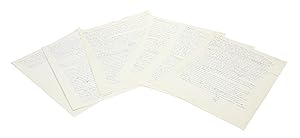
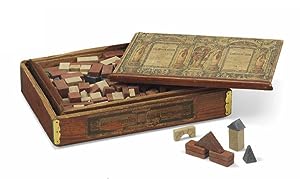
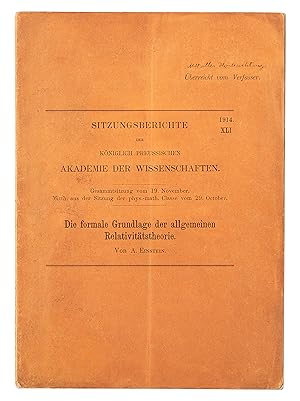
![Imagen del vendedor de Einstein: My Work in Relativity Supplanted Newtonian Mechanics and Changed Our Notion of Space and Time Forever ("In classical mechanics, space and time were completed existences, which had to be presupposed as real [a priori] in order to give meaning to the laws of motion. It was a reality in the same sense as the reality of matter; even governing the latter. In this sense Kant was entirely wrong.") a la venta por The Raab Collection](https://pictures.abebooks.com/inventory/md/md30771263176.jpg)
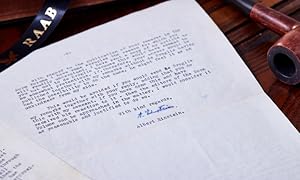
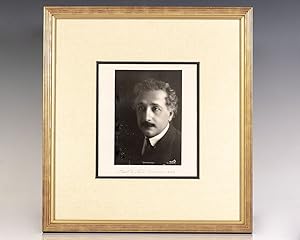
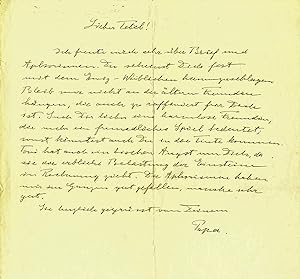
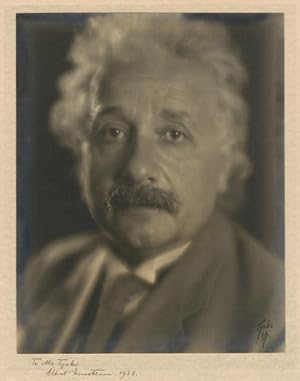
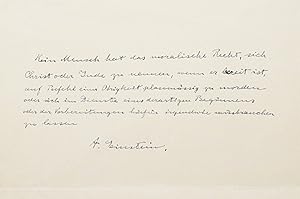
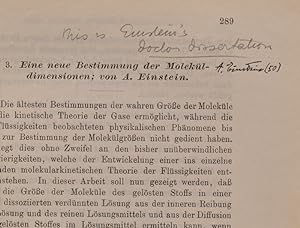
![Imagen del vendedor de Einstein at Work [Suite of Seven Photographs] a la venta por Manhattan Rare Book Company, ABAA, ILAB](https://pictures.abebooks.com/inventory/md/md31326176817.jpg)
